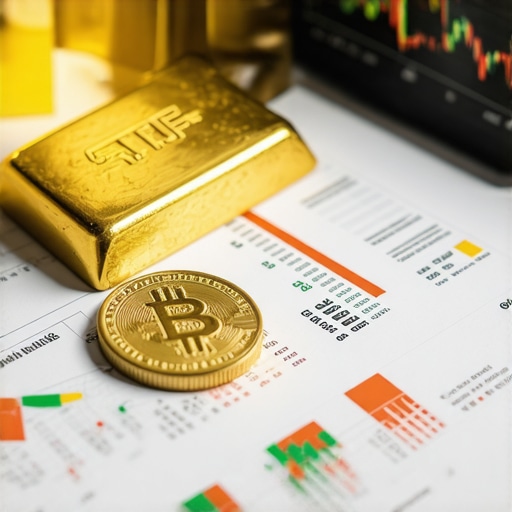Unlocking the Gold Investment Puzzle: ETFs or Physical Gold?
In the labyrinth of investment choices, gold remains a timeless refuge for wealth preservation and portfolio diversification. Yet, the decision between investing in Gold ETFs or acquiring physical gold is far from straightforward. Each option offers unique advantages, risks, and strategic implications. Understanding these nuances can transform your investment approach from mere speculation to informed asset allocation aligned with your financial goals.
Weighing the Tangibility: The Allure and Challenges of Physical Gold
Physical gold, in the form of bullion bars or coins, appeals to investors who value direct ownership and tangible assets. This form of investment offers a sense of security, especially in geopolitical or economic crises where paper assets may falter. However, owning physical gold entails storage, insurance, and liquidity considerations that can erode net returns. For example, safely storing gold bars demands secure vaults or safety deposit boxes, often at a recurring cost, which may deter small-scale investors.
Gold ETFs: Digital Gold with Liquidity and Flexibility
Gold ETFs (Exchange-Traded Funds) provide exposure to gold prices without the need to handle physical assets. These funds trade like stocks on exchanges, offering high liquidity and ease of transaction. Investors benefit from lower entry thresholds and reduced storage concerns, making ETFs attractive for portfolio diversification and tactical trading. Yet, the indirect nature of ETFs introduces counterparty risk and management fees, which may affect long-term performance compared to holding physical gold.
How Does Market Volatility Influence the Choice Between Gold ETFs and Physical Gold?
Market turbulence often prompts investors to reassess gold holdings. Physical gold is prized during extreme crises for its intrinsic value and independence from financial institutions. Conversely, Gold ETFs excel in volatile markets offering swift entry and exit, facilitating tactical adjustments. A balanced approach might involve holding a core position in physical gold for security, complemented by tactical ETF exposure to capitalize on market movements. This dual strategy harnesses both stability and flexibility, crucial in navigating unpredictable economic landscapes.
Expert Tip: Aligning Your Gold Investment With Portfolio Objectives
Experienced investors recommend evaluating your investment horizon, liquidity needs, and risk tolerance when choosing between Gold ETFs and physical gold. For long-term wealth preservation, physical gold serves as a robust hedge against inflation and currency devaluation. For active portfolio management and short-term trading, Gold ETFs offer accessible and cost-efficient exposure. To deepen your understanding of Gold ETFs, consider exploring this comprehensive guide that breaks down top funds and diversification strategies.
According to the World Gold Council, gold consistently acts as a safe haven asset during market downturns, underscoring the importance of strategic allocation between physical and paper gold investments (World Gold Council Research).
What’s your take on balancing gold investments? Share your experiences or questions in the comments below to join the conversation and learn from fellow investors.
Tax Implications and Regulatory Considerations in Gold Investments
Investors often overlook the tax nuances that differentiate physical gold from Gold ETFs. Physical gold, such as bullion and coins, is generally classified as a collectible by tax authorities in many jurisdictions, subjecting gains to higher capital gains tax rates compared to other assets. Additionally, the sale of physical gold may incur sales taxes or VAT depending on local laws. Conversely, Gold ETFs typically enjoy more favorable tax treatment, akin to stocks or mutual funds, with clearer reporting and sometimes lower tax rates on dividends or capital gains.
Regulatory frameworks also influence investment choices. Physical gold transactions may require compliance with anti-money laundering (AML) regulations and identity verification, potentially complicating quick trades. Meanwhile, Gold ETFs are regulated under securities laws, offering transparency, standardized pricing, and investor protections but exposing investors to counterparty risks linked to the fund’s management and custodianship. Understanding these factors is essential for sophisticated portfolio construction.
Integrating Gold Investments Within a Diversified Portfolio Strategy
Gold’s unique characteristics as a non-correlated asset make it a strategic diversifier. When integrated carefully, both physical gold and Gold ETFs can reduce overall portfolio volatility and enhance risk-adjusted returns. Physical gold serves as a long-term inflation hedge and crisis hedge, while ETFs provide tactical exposure that can be adjusted based on market conditions.
For instance, institutional investors often allocate a core percentage to physical holdings for stability, complemented by ETF positions to capture short-term price movements or to gain exposure in markets where physical acquisition is less feasible. Retail investors can emulate this approach by balancing holdings according to their liquidity needs and investment timelines.
Could Dynamic Allocation Between Gold ETFs and Physical Gold Enhance Portfolio Resilience?
Exploring a dynamic allocation strategy involves periodically adjusting the mix of physical gold and Gold ETFs in response to market signals, economic indicators, and personal financial goals. For example, during periods of rising inflation expectations or geopolitical tensions, increasing physical gold exposure might provide greater security. Conversely, in stable economic phases with bullish equity markets, tactical ETF exposure could optimize returns due to ease of trading and lower costs.
Such an adaptive strategy demands continuous market monitoring and a clear understanding of the macroeconomic environment. It also requires awareness of the liquidity and cost implications inherent in shifting between physical and paper gold forms.
Advanced Hedging Techniques Using Gold Instruments
Beyond straightforward ownership, advanced investors can leverage gold derivatives and futures to hedge against market downturns or portfolio risks. Gold futures contracts allow locking in prices or speculating on short-term movements with leverage, while options on gold ETFs provide strategies to limit downside risk while maintaining upside potential.
Combining physical gold holdings with derivative instruments can offer a layered defense against inflation and currency depreciation while managing liquidity and capital efficiency. However, these strategies entail complexities and risks requiring expertise and active management.
For a deeper dive into effective gold trading techniques and maximizing profits with futures, consider reading this expert guide.
Expert Perspectives: Analyzing Gold Market Trends and Investor Behavior
Recent analyses by the International Monetary Fund (IMF) highlight that central bank gold purchases and geopolitical uncertainties significantly influence gold price dynamics. Central banks’ strategic accumulation of gold boosts demand fundamentals, impacting both physical and ETF markets. Investors should track these macro-level trends to anticipate price movements and adjust their allocations accordingly (IMF Working Paper on Gold Reserves).
Understanding behavioral finance aspects is equally crucial. Investor sentiment swings can cause temporary divergences between ETF prices and physical gold values, creating arbitrage opportunities for skilled traders with access to both markets.
Engage with this evolving landscape by sharing your strategies or questions about gold allocation in the comments. Your insights contribute to a richer community dialogue, helping investors refine their approaches amid market complexities.
Decoding Tax Complexities: Strategic Implications for Gold Investors
Tax treatment of gold investments varies widely across jurisdictions, profoundly impacting net returns and portfolio strategy. Recognizing the distinction between physical gold and Gold ETFs is critical. Physical gold often falls under collectible asset classifications in countries like the United States, subjecting gains to capital gains tax rates up to 28%, significantly higher than the standard rates on equities or mutual funds. Additionally, Value-Added Tax (VAT) applies in many European nations on bullion purchases, though exemptions exist for investment-grade gold under specific criteria, such as minimum purity levels and form.
Conversely, Gold ETFs typically benefit from more conventional securities tax regimes. For instance, in the UK, gains on Gold ETFs are treated similarly to shares, with access to capital gains tax allowances, while dividends or distributions may be taxed under income tax rules. Understanding such nuances allows investors to optimize tax efficiency by choosing the appropriate investment vehicle aligned with their tax residency and holding period.
How Can Investors Navigate Regulatory Compliance Without Compromising Agility in Gold Trading?
Regulatory frameworks impose varying degrees of compliance requirements on gold transactions. Physical gold purchases often trigger Know Your Customer (KYC) and Anti-Money Laundering (AML) protocols, especially for higher-value transactions, potentially complicating rapid acquisitions or liquidations. In contrast, Gold ETFs, governed under securities laws, offer streamlined transaction processes with robust investor protections but introduce counterparty and operational risks tied to fund managers and custodians.
Advanced investors can mitigate these challenges by employing multi-jurisdictional custodial arrangements or leveraging regulated trading platforms that ensure compliance while maintaining transactional agility. Moreover, integrating automated compliance tools and blockchain-based provenance verification for physical gold can enhance transparency and reduce regulatory friction.
Integrating Gold’s Regulatory and Tax Dimensions into Sophisticated Portfolio Architecture
Incorporating tax and regulatory considerations into gold investment strategies demands a holistic approach. Portfolio architects must weigh not only market dynamics but also jurisdiction-specific fiscal impacts and compliance burdens. For example, a high-frequency trader might prefer Gold ETFs to capitalize on liquidity and lower transaction costs, while a long-term wealth preserver may accept physical gold’s storage and tax costs in exchange for sovereignty and inflation hedging.
Institutional frameworks increasingly adopt layered strategies, combining physical holdings in low-tax jurisdictions with ETF exposure for tactical flexibility. This diversification extends beyond asset classes to include regulatory environments, optimizing overall risk-adjusted returns.
For authoritative guidance on international tax implications of gold investments, refer to the detailed analyses provided by Deloitte in their Global Gold Taxation Report.
Emerging Trends: Digital Gold and Regulatory Innovation
The advent of blockchain-based digital gold tokens introduces a transformative layer to traditional gold investing. These tokens represent fractional ownership of physical gold stored in secure vaults, blending the tangibility of physical gold with the liquidity and transparency of digital assets. Regulatory bodies are beginning to address this hybrid asset class, crafting frameworks that balance investor protection with innovation facilitation.
Investors considering digital gold must evaluate the custodial integrity, smart contract security, and jurisdictional acceptance of such instruments. As regulations evolve, staying informed on compliance developments becomes paramount to harnessing digital gold’s full potential as a portfolio diversifier and inflation hedge.

Exploring the Intersection of Gold Investment Strategies and Macroeconomic Indicators
Advanced portfolio management leverages macroeconomic signals—such as interest rate trajectories, currency fluctuations, and geopolitical risk indices—to dynamically adjust gold allocations. For instance, rising real interest rates typically exert downward pressure on gold prices, whereas heightened geopolitical tensions often spur demand for physical gold as a safe haven.
Integrating econometric models and machine learning algorithms can enhance predictive accuracy, enabling investors to preemptively rebalance between physical gold and Gold ETFs. This quantitative approach complements qualitative assessments, offering a comprehensive toolkit for maximizing gold’s strategic value.
To delve deeper into how macroeconomic factors influence gold investment performance, consult the seminal work “Gold and the Macroeconomy” published by the National Bureau of Economic Research.
Engage with this discourse by sharing your perspectives or inquiries below, enriching our collective expertise on harnessing gold for resilient portfolio construction amid evolving economic landscapes.
Advanced Portfolio Design: Leveraging Behavioral Finance in Gold Investment
Incorporating behavioral finance principles into gold investment strategies offers a nuanced understanding of investor psychology and market sentiment. Recognizing cognitive biases such as herd behavior or loss aversion can refine timing decisions between physical gold acquisition and Gold ETF exposure. For example, during periods of exuberant market optimism, investors may underestimate gold’s hedging benefits, thereby under-allocating physical gold. Conversely, fear-driven sell-offs can create transient mispricings in Gold ETFs, presenting tactical entry points for astute market participants.
Blockchain’s Role in Enhancing Transparency and Trust in Gold Ownership
Blockchain technology is revolutionizing gold provenance verification and ownership tracking, addressing long-standing concerns about authenticity and counterparty risk in both physical and digital gold assets. Distributed ledger systems enable immutable records of gold custody chains, facilitating investor confidence and regulatory compliance. This innovation not only mitigates fraud but also streamlines settlement processes, fostering liquidity and interoperability across global gold markets.
What Are the Key Risks and Opportunities in Integrating Blockchain with Traditional Gold Investments?
While blockchain offers enhanced transparency and efficiency, challenges persist, including regulatory uncertainty, technological scalability, and cybersecurity threats. Investors must assess the robustness of smart contracts underpinning digital gold tokens and the custodial arrangements securing physical gold backing these tokens. On the opportunity front, blockchain integration can unlock fractional ownership models, reduce transaction costs, and broaden access to gold investments for diverse investor demographics. Balancing these factors demands a sophisticated due diligence framework and ongoing market surveillance.
Strategic Tax Planning: Optimizing Gold Investment Returns Through Jurisdictional Expertise
Proactive tax planning is indispensable for maximizing net returns on gold investments. Utilizing tax-advantaged accounts, understanding treaty benefits, and timing disposals to capitalize on favorable long-term capital gains regimes can substantially enhance profitability. Furthermore, structuring gold holdings via offshore entities in jurisdictions with beneficial tax treaties and robust legal frameworks can mitigate withholding taxes and inheritance liabilities, albeit requiring meticulous compliance with international tax laws.
Harnessing Quantitative Models: Predictive Analytics for Gold Price Movements
Advanced investors increasingly rely on quantitative models incorporating machine learning algorithms, sentiment analysis, and macroeconomic indicators to forecast gold price trajectories. Such models assimilate voluminous data sets—ranging from interest rate differentials and currency strength to geopolitical event probabilities—yielding probabilistic insights that inform dynamic allocation adjustments between physical gold and ETFs. Embracing these analytic tools elevates decision-making precision beyond traditional heuristics.
Global Regulatory Shifts: Navigating Emerging Compliance Landscapes in Gold Trading
Regulatory regimes worldwide are evolving to address the complexities introduced by digital gold assets and cross-border transactions. Enhanced AML/KYC protocols, data privacy mandates, and securities law interpretations are reshaping gold market operations. Investors and fund managers must remain vigilant to these developments to avoid compliance pitfalls and leverage regulatory arbitrage where permissible. Collaborating with specialized legal counsel and adopting compliance automation solutions are strategic imperatives in this environment.
Engage With Pioneering Gold Investment Approaches
For an authoritative perspective on the intersection of blockchain and gold investments, explore the detailed analysis presented by the Investopedia article on Blockchain in Gold Markets. This resource elucidates the transformative potential and practical considerations of this emerging paradigm.
Elevate your gold investment strategy by integrating these advanced insights. Share your experiences, ask nuanced questions, or discuss innovative techniques in the comments below to contribute to an expert-level dialogue that sharpens collective acumen in this sophisticated asset class.
Frequently Asked Questions (FAQ)
What are the main differences between investing in physical gold and Gold ETFs?
Physical gold offers direct ownership of tangible assets, providing security during crises but involves storage, insurance, and liquidity challenges. Gold ETFs provide convenient, liquid exposure to gold prices without handling physical assets, but introduce counterparty risk and management fees.
How do tax implications differ between physical gold and Gold ETFs?
Physical gold is often taxed as a collectible with higher capital gains rates and may incur VAT or sales taxes depending on jurisdiction. Gold ETFs usually benefit from standard securities tax treatment, often resulting in more favorable capital gains rates and simpler reporting.
Can combining physical gold and Gold ETFs improve portfolio resilience?
Yes, a balanced allocation leverages physical gold’s role as a long-term hedge and safe haven with ETFs’ liquidity and tactical flexibility, allowing dynamic adjustments to market conditions and personal financial objectives.
What role does blockchain technology play in modern gold investing?
Blockchain enhances transparency, provenance verification, and ownership tracking for both physical and digital gold assets, reducing fraud and improving liquidity. It also enables fractional ownership through digital gold tokens, though regulatory and technological challenges remain.
Are gold derivatives suitable for hedging in a gold investment strategy?
Advanced investors use gold futures and options to hedge risks or speculate on price movements with leverage. While they offer capital efficiency and downside protection, these instruments require expertise and active management due to their complexity.
How do macroeconomic factors influence gold investment decisions?
Interest rates, inflation expectations, currency fluctuations, and geopolitical risks significantly impact gold prices. Understanding these indicators aids in adjusting allocations between physical gold and ETFs to optimize risk-adjusted returns.
What regulatory challenges should gold investors be aware of?
Physical gold transactions often require stringent AML/KYC compliance, which can slow trades, while Gold ETFs are subject to securities regulations with investor protections but introduce counterparty risks. Emerging digital gold assets face evolving regulatory scrutiny globally.
How can investors optimize tax efficiency in gold investments?
Strategic planning includes utilizing tax-advantaged accounts, understanding jurisdictional tax regimes, timing disposals for favorable capital gains treatment, and structuring holdings across beneficial tax jurisdictions, always ensuring compliance with international laws.
What behavioral biases affect gold investment timing and allocation?
Biases like herd behavior and loss aversion can cause under- or over-allocation to gold during market cycles. Awareness of these psychological factors can improve timing decisions between physical gold and ETFs for better portfolio outcomes.
Is dynamic rebalancing between physical gold and ETFs feasible for retail investors?
While dynamic allocation enhances portfolio resilience, it requires market monitoring and understanding of liquidity and cost trade-offs. Retail investors can implement simplified versions aligned with their risk tolerance and investment horizons.
Trusted External Sources
- World Gold Council – Provides comprehensive research and data on gold investment trends, market dynamics, and safe haven properties, essential for understanding gold’s role in diversified portfolios.
- International Monetary Fund (IMF) – Offers in-depth analyses on central bank gold reserves and macroeconomic impacts on gold prices, crucial for grasping global demand fundamentals.
- National Bureau of Economic Research (NBER) – Publishes seminal academic papers on gold’s relationship with macroeconomic indicators, enhancing quantitative investment modeling.
- Deloitte Global Gold Taxation Report – Delivers authoritative insights into cross-jurisdictional tax treatments and regulatory frameworks affecting gold investments worldwide.
- Investopedia – Blockchain in Gold Markets – Explores the intersection of blockchain technology and gold investing, clarifying opportunities and challenges in digital gold innovations.
Conclusion
Choosing between physical gold and Gold ETFs requires a nuanced understanding of their distinct characteristics, tax implications, regulatory environments, and the evolving landscape shaped by technological innovations and macroeconomic forces. Physical gold remains a steadfast hedge and crisis asset, while Gold ETFs provide liquidity and tactical flexibility for active portfolio management. Integrating behavioral finance insights and advanced quantitative models can further refine allocation strategies, enhancing resilience and return potential.
Embracing emerging trends like blockchain-based digital gold and dynamic allocation approaches empowers investors to navigate complexities with sophistication. Ultimately, a well-informed, adaptable strategy that aligns gold investments with individual objectives and market conditions unlocks gold’s full potential as a cornerstone of diversified portfolios.
We invite you to share your thoughts, ask questions, or explore our related expert content to deepen your mastery of gold investment strategies and optimize your financial journey.











I’ve been wrestling with the decision between physical gold and Gold ETFs for a while now, and this post really captures the complexity involved. Personally, I lean towards holding physical gold as a core hedge because having tangible assets gives me peace of mind during uncertain times, especially considering geopolitical risks. However, I agree that the storage and insurance costs can eat into returns, which is why I’ve started exploring a modest allocation in Gold ETFs. Their liquidity and ease of trading make them ideal for more tactical moves, especially when market volatility spikes.
One thing that stood out to me was the idea of a dynamic allocation strategy—adjusting the balance between physical gold and ETFs based on economic indicators sounds promising, but it also seems to demand a lot of market monitoring and flexibility. I wonder how retail investors without advanced tools can realistically implement such strategies without incurring excessive costs or risks.
Also, I’m curious if others have found efficient ways to tackle the tax and regulatory challenges mentioned here? Particularly, how do you navigate the higher capital gains taxes on physical gold in certain jurisdictions while still maintaining a meaningful position? It would be great to hear strategies or experiences that have worked in different regions or tax environments.
This post highlights some crucial points that many overlook when choosing between physical gold and ETFs. From personal experience, I’ve found that maintaining a core holding of physical gold provides peace of mind, especially during turbulent times when trust in financial institutions can waver. However, I’ve also incorporated ETFs for tactical flexibility, which has proven useful during periods of market volatility.
Regarding the dynamic allocation strategy mentioned, I think it’s a brilliant approach but admittedly challenging for retail investors who lack sophisticated tools or real-time data. One way to simplify this could be setting predetermined thresholds—for example, increasing physical gold allocation during high inflation periods and shifting more into ETFs during stable times.
As for tax considerations, in my jurisdiction, structuring physical gold holdings within tax-advantaged accounts or using specific investment vehicles has helped mitigate some tax burdens. Have others successfully used offshore accounts or different legal entities to optimize tax efficiency? It would be interesting to hear how different regions approach this balancing act.